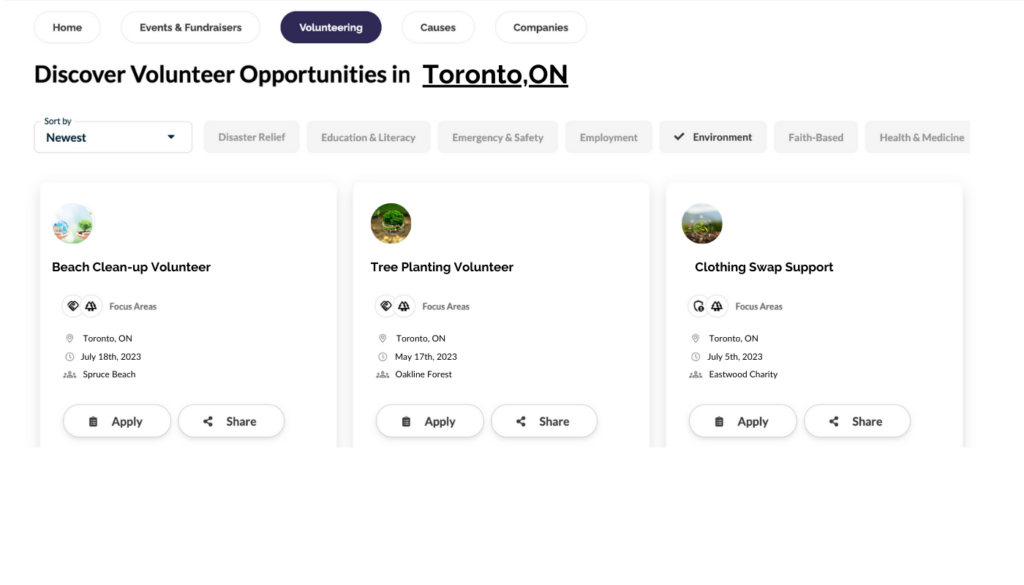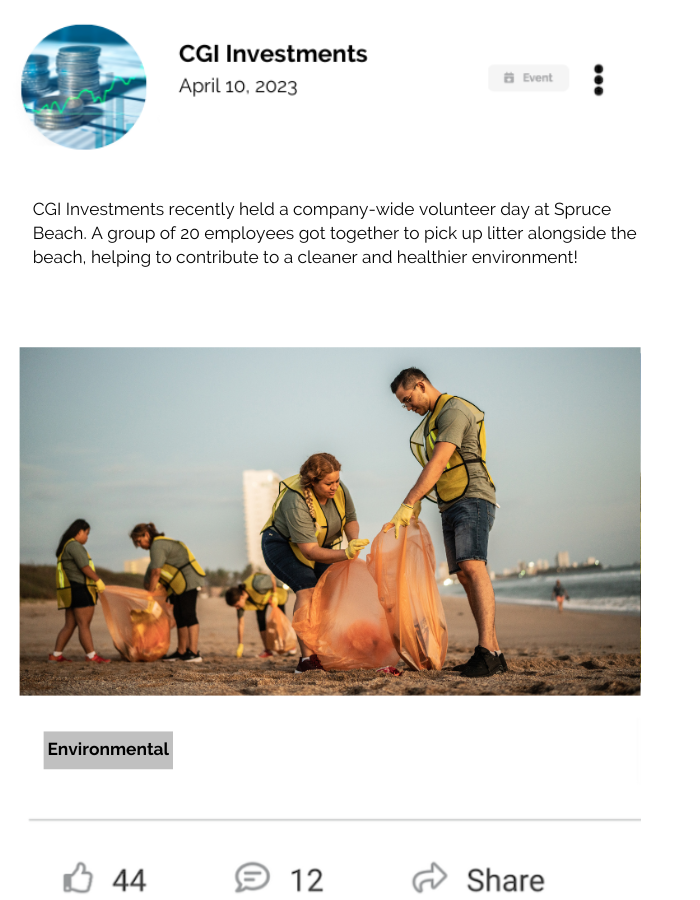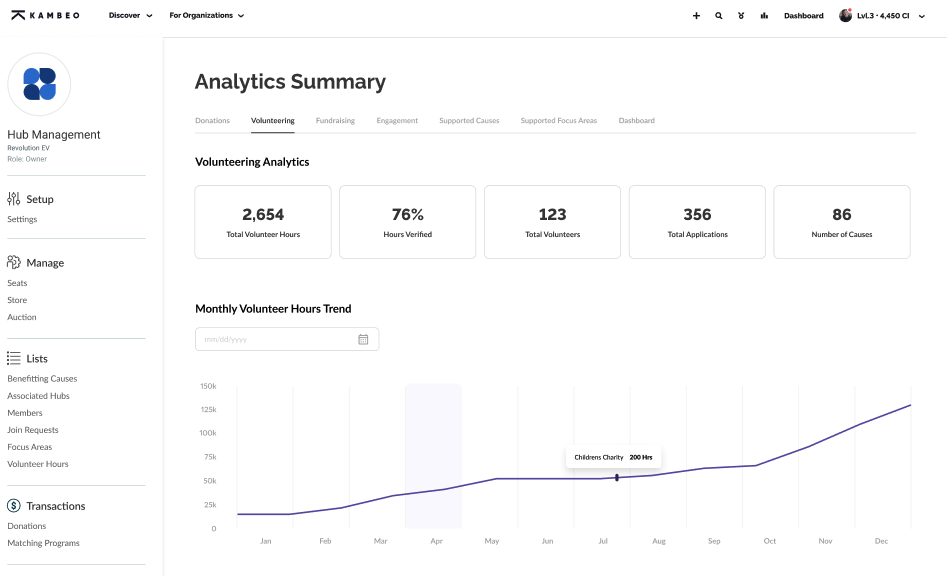Employees build customer relationships, improve brand awareness, enhance user experience, and develop products.
As employees play a pivotal role in carrying out a company’s mission and helping to achieve revenue, their well-being is essential to ensure they are performing their best. However, with only 33% of employees reported to be “thriving” in their well-being, there is room for growth.
What can your organization do to help boost your employee’s well-being? Implement corporate volunteerism through a defined program.
Through volunteering, employees can develop new skills, explore social connections, and pursue their passions through the support of their employer. Simply put, when organizations take the time to focus on employee well-being and implement a volunteer program, employees will feel recharged and refreshed: the key to productivity.
This guide aims to explore the benefits of company volunteering while providing actionable steps to implement, measure, and create a volunteer program.
What is corporate volunteerism?
Corporate volunteerism refers to opportunities for employees to work together, gain new skills, and show kindness to their local community.
As many organizations look to add a corporate volunteerism component to the workplace, a company volunteer program is implemented in order to effectively plan, optimize, and measure volunteer activity across the company.
The essential components of a company volunteer program are as follows:
- Organizing corporate volunteer days (both in-person and remote)
- Helping employees discover individual volunteer opportunities
- Maximizing volunteer participation
- Tracking your cumulative volunteer impact
Benefits of corporate volunteerism
Increased employee retention
Engaged employees are 87% less likely to leave their organization. Engaged employees are defined as those who feel strongly connected to their organization; they care about the growth and prosperity of their company and work efficiently to help their organization achieve a noteworthy level of success.
However, for employees to feel connected to their organization and have a deep desire to perform at their best, it comes down to “What’s in it for me?” In other words, beyond a paycheque, what else is their company providing that is beneficial to them?
Enter a company volunteer program. Whether it be through a company-organized beach clean-up day or individual volunteer opportunities that employees can choose to connect with on company time, volunteering boosts employee morale, making them less likely to leave their organization.
How does a corporate volunteer program improve morale? Volunteer programs go beyond providing standard health coverage or flexible spending accounts, these programs help employees reduce stress, form meaningful bonds with colleagues, and improve energy levels: all factors contributing to employee well-being. And when employees flourish physically, mentally, and emotionally—stemming from the programs your organization offers—employee turnover decreases.
Improved employee relationships
When teams work together to carry out a work-related project, they become stuck in a recurring cycle that includes brainstorming and status update meetings.
What these meetings fail to achieve is creating an environment where employees can explore shared values, build comradery, and embrace a spirit of giving together. When employees are provided with opportunities to work closely together through a company-organized volunteer day, these key benefits are brought to life.
For instance, a group of employees might all value kindness, and through a volunteer day, they are each able to perform tasks that support individuals in need. With these volunteer tasks performed in close proximity, all rooted in the value of kindness, employees will feel more connected through this shared experience.
Development of new skills
Valuable hard skills, such as communication, time management, and organization can be learned (and improved upon) in environments beyond the workplace.
Looking at a hard skill, such as communication, you may be wondering how corporate volunteerism can help employees become better communicators.
One characteristic of volunteering is universal: teamwork. If an employee partakes in a company-wide volunteer day, they are working closely alongside their colleagues to carry out acts of service and make a difference together. On the other hand, if an employee chooses to take a paid volunteer day to volunteer at their local animal shelter, they are working alongside community volunteers (from all walks of life) to problem solve and collaborate in order to achieve a common goal. By working with others, employees can improve upon their listening, observing, and empathizing abilities, each important aspects of effective communication.
Steps to setting up a company volunteer program
Now that we know some of the benefits of volunteering, let’s dive in on how to set up a company volunteer program.
In accordance with any volunteer program, the first step is to arrange for your employees to volunteer together (either in person or remotely). In-person volunteering provides invaluable opportunities for face-to-face teamwork and collaboration, while remote volunteering can be equally as effective at bonding employees by allowing them to work together toward a common goal
Step 1: Organize corporate volunteer days (remote & in-person)
- Tree planting- Identify the best area for tree planting in your region by coordinating with an environmental nonprofit. Organize your employees in small groups to plant trees at designated spots throughout the chosen area.
- School supply drive- Make an announcement encouraging your employees to bring in backpacks and an array of school supplies (i.e., markers, pencils, journals, rulers, etc..). On a designated day, organize a time when your employees can stuff and deliver the backpacks full of school supplies to local schools.
- Beach clean-up- Obtain the required supplies, such as trash bags, gloves, and litter pickers for a beach clean-up day. Once the volunteer day commences, allow employees to choose how they want to participate: whether they want to distribute supplies, pick up litter, or oversee the entire clean-up process.
- Trail clean-up (remote)- Employees can all take one paid volunteer day off together to venture out into their respective communities and pick up trash along a trail in their neighbourhood. Once the volunteer day is completed, a video call can be scheduled where each employee shares the highlights and accomplishments of their day.
- Afterschool coaching (remote)- Employees can assist high school students with completing their university applications, provide post-secondary education advice, or even help students work on their resumes to apply for part-time jobs. Similar to a group project, each employee’s strengths will shine, helping that student succeed more than they would have with just a single employee volunteer.
Step 2: Help employees discover individual volunteer opportunities
Another way to motivate and encourage employees to volunteer is by helping them connect with individual volunteer opportunities.
Employees may not have the free time to discover and apply for volunteer opportunities in their communities. This is where volunteer software comes in, driven by your organization. Its capabilities are simple yet powerful, providing one platform for your employees to browse through hundreds of volunteer opportunities being organized in their community and apply to these positions directly.
These individual volunteer opportunities give employees an outlet to volunteer with causes they may have strong personal connections to or causes they have always wanted to volunteer with but haven’t had the time to pursue outside of work.
How does volunteer software work?
- Using Kambeo, employees can select the ‘Volunteer’ tab in the header.
- Kambeo will detect that employee’s location and all current volunteer opportunities in their area will populate.
- To further refine their search, employees can browse through specific volunteer opportunities pertaining to focus areas (i.,e community, environment, disaster relief).
- For example, if an employee clicks on the ‘Environment’ focus area, a list of volunteer opportunities related to environmental sustainability and conservation (happening in their neighbourhood) will appear.
- After an employee finds a volunteer opportunity of interest, they can directly apply through the platform.

Step 3: Maximize volunteer participation
Capitalize on the team aspect of volunteering
Employees want another method, aside from standard meetings and departmental collaboration, to collaborate, communicate, and connect. Considering that volunteering brings employees together in an informal environment during company time, many employees view team volunteering opportunities as beneficial for developing their interpersonal skills. In fact, 80% of employee-supported volunteers believe that group volunteering strengthens their relationships with colleagues.
Therefore, aim to host two company-wide volunteer days per year. Choose a location, time, and volunteer activity, making sure to communicate these logistics company-wide.
Share photos and accomplishments
Once a company-wide volunteer day has been completed, now is the time to share the results of this day through photos, videos, and captions.
Kambeo’s social impact platform melds together social media with the world of social good. The difference between Kambeo and social media? Kambeo distributes content focused on social impact, whereas other social media platforms display an array of promotional, educational, and inspirational posts.

Using Kambeo’s interactive activity feed, companies can create a post—uploading a photo or video with a caption—to their feed. Once posted, a company’s internal stakeholders following their page (i.e., their customers, employees, and shareholders) can engage with the post.
Provide volunteer time off
Whether employees are volunteering as part of a company-wide volunteer day or pursuing a volunteer initiative of their own, provide paid volunteer time off. As a rule of thumb, it is recommended to give your employees 4 paid volunteer days a year (one per quarter).
Recognize and reward participation
Whether through verbal praise, gift cards, or an all-expenses-paid day off, employees want to be recognized and rewarded for the work they do. This philosophy stands true in the world of volunteering, as employees are putting forth a considerable amount of time and effort toward achieving a goal.
For example, send all of your employees a handwritten card as a token of appreciation for all of their volunteer accomplishments. If you want to spur some friendly competition between employees, gift the employee(s) who have accumulated the most volunteer hours with an all-expenses-paid spa day.
Regardless of the reward, make sure no employee volunteer effort goes unnoticed. Rewarding and recognizing employees makes them feel more connected to your organization, elevates volunteer performance, and increases the likelihood they will continue volunteering in the long run.
Step 4: Track your volunteer impact
Without tracking your volunteer efforts, your organization won’t truly understand how much of an impact you have had on your local communities. Below are a few volunteer metrics any company can track using Kambeo:
- Number of volunteers- Track how many employees have volunteered on behalf of your organization.
- Volunteer hours- Monitor how many volunteer hours your employees have contributed month-over-month.
- Additionally, track ‘total volunteer hours’, which represents the cumulative volunteer hours your employees have contributed. *Once an employee logs their volunteer hours on the platform, this will be added to ‘total volunteer hours’.
- Additionally, track ‘total volunteer hours’, which represents the cumulative volunteer hours your employees have contributed. *Once an employee logs their volunteer hours on the platform, this will be added to ‘total volunteer hours’.
- Number of causes supported- Track the number of charities or nonprofits supported through your company’s volunteer efforts.

Corporate volunteerism goes beyond connecting employees to their communities. Volunteering provides an outlet for employees to improve their mindset, boost their mood, and reduce their stress levels.
Corporate volunteerism only requires a few simple steps to execute, and Kambeo can help you each step of the way. Provide your employees with an outlet to improve their well-being today.



